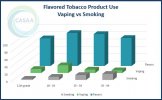We recently posted about claims that "vaping threatens to undo years of work by public health" and this article is a perfect example.
As we showed with the chart in that previous post, there's no evidence to support that claim, but in this Lund Report article, the American Lung Association uses misdirection, a sly use of the common understanding of certain definitions and the purposeful omission of facts in an attempt to convince an unwitting public that youth vaping is an "epidemic."
We're going to break it down so you can learn to spot this type of obfuscation for yourself in the future!
"New research found that teenage vaping threatens to undo years of work by public health officials to cut down on tobacco use."
This statement omits any evidence to back it up. (Note how vaping is called "tobacco use" here. That will come up later.) As our previous post pointed out, not only has smoking declined dramatically for teens and young adults over the past 20 years, but the decline was greater in the past 10 years than it was in the previous decade.
"The National Youth Tobacco survey of more than 22,000 students nationwide in 2023 found that 10% of U.S. secondary students vape nicotine, which is more than those who use all other tobacco combined."
This is a sly use of what the public would understand as "tobacco." Remember how they called vaping "tobacco use" earlier?
Yes, 1.56 million high school youth reported current vaping (remember, that means "even one puff in the past 30 days") vs. the 1.21 million who used other "tobacco." However, if you include nicotine pouches and "other" oral nicotine products (regulated as "tobacco products" by the FDA,) that number rises to 1.65 million using tobacco and nicotine products other than e-cigarettes.
Funny how certain nicotine products are only referred to as "tobacco" when it fits the narrative.
The misdirection comes into play in that previous statement by not telling you that just 12.6% of high school youth used ANY tobacco or nicotine product in 2023. Compare this to 28.4% a little over 20 years ago in 2002.
Additionally, cigarette smoking -- arguably the most harmful form of tobacco/nicotine use -- has dropped from 22.9% in 2002 to just 1.9% in 2023. The number of youth using tobacco AND nicotine products (including e-cigarettes) today is about HALF the number of youth who were smoking 20 years ago! (See graph above.)
The ALA spokesperson, Erica Heartquist, "told the Capital Chronicle that 75% of 11th graders who use tobacco consume flavored products. But that appeal wanes with age: Two-thirds of adults in Oregon aged 18 to 24 reported consuming flavored nicotine products, while half that of those 25 to 34 did and only 13% of adults at least 35 years old used flavored products."
More misdirection and omission of facts. The insinuation here is that adults have no interest in flavors, so flavors MUST only exist to attract youth.
What they don't tell you is that the adults over the age of 35 using "tobacco or nicotine products" are far more likely to still be SMOKING (partly due to anti-vaping scaremongering). Of course adults over age 35 aren't using flavored products, because most of them are smoking cigarettes and flavored cigarettes have been banned for about 15 years!
In Oregon, 12.6% of adults were smoking in 2021 and only 6.9% were using e-cigarettes. Most of the adults using e-cigarettes in 2021 were under the age of 35. Conversely, 10.8% of 11th graders were vaping in 2022 and smoking had dropped to just 3.2% (down from 19.9% in 2002.) Furthermore, vaping in that group was down SIGNIFICANTLY from the high of 23.4% in 2019. (See:
Oregon Health Authority : Oregon Tobacco Facts : Tobacco Prevention : State of Oregon)
This graph illustrates how more vaping in these age groups corresponds with more flavor use, while more smoking corresponds with less flavor use:
However, when you survey adults who exclusively use smoke-free nicotine products, they prefer non-tobacco flavors, as well. One study found that "among current vapers, the percentage of those who used flavored e-cigarettes was higher for adults aged 18-24 years (89.6%), 25-34 years (86.7%), and 35-44 years (76.0%) than for adults aged 45 years and older (60.4%)," but note how even the 45 years and older group of vapers was not much lower than the 75% for 11th graders.
See:
Prevalence of Flavored e-Cigarette Use Among Subpopulations of Adults in the United States
And that, dear readers, is how they are able to mislead the public with "facts" while still hiding the truth. Now you know.
READ ARTICLE:
Use of flavored nicotine products poses ‘critical’ clinical challenges, review says | The Lund Report










